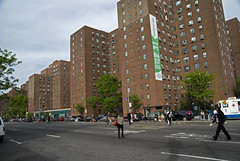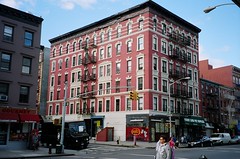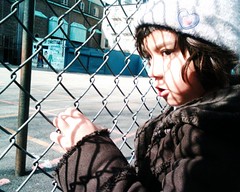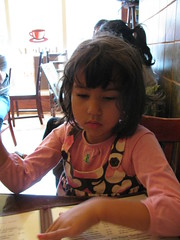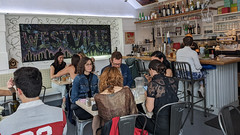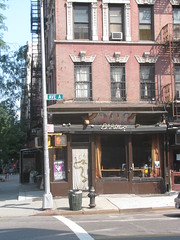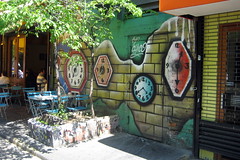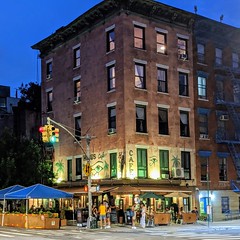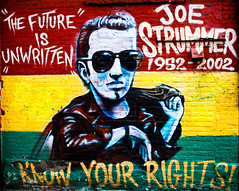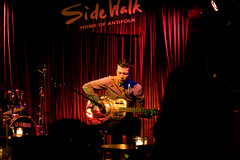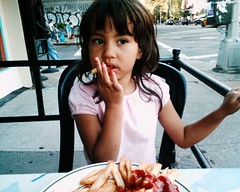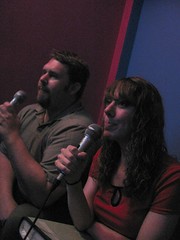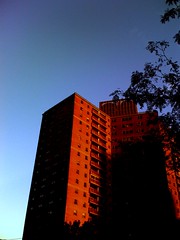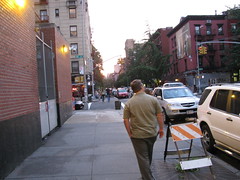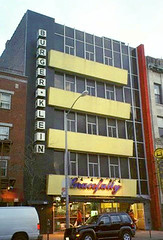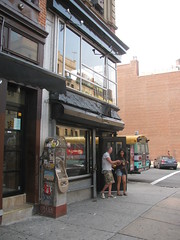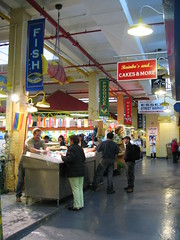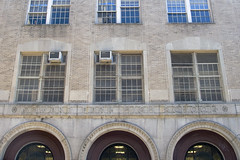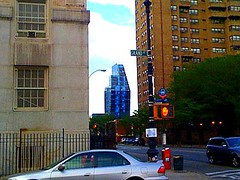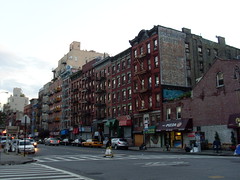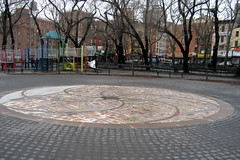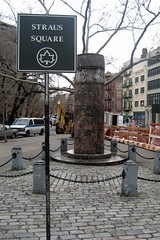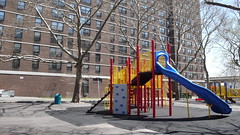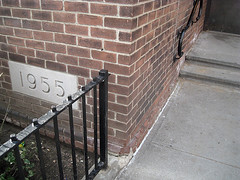West:
St. Nicholas Church
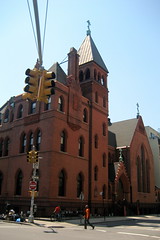
Corner (288 E. 10th): Carpatho-Russian Greek
Orthodox Catholic Church. Built 1883 as St. Mark's Memorial
Chapel,
designed by St Patrick's Cathedral architect
James Renwick Jr. A beautiful Gothic
Revival building; note St Mark's lion on north
side. Both north and east walls have faces
made of leaves--a romanesque motif known as
a
foliate mask--that is believed to be
a pagan survival, and is interpreted as
representing the Green Man, a vegetation god.
155: The address of the Leonardo da Vinci
Art School (1924-1940)
153: Tompkins Square Finest Deli
151: Quick Repair on A was Mamani, dollar pizza; before that Lite Touch on A, tasty and cozy
Middle Eastern hole-in-wall; Live Shop Die, a hippy
boutique, used to be here. At the same address was
San Loco, taco mini-chain.
149: Blank Street Coffee was Sara Samoiloff Jewelry
147: Village Square Pizza was Tompkins Square Studio, crafts. Earlier was the offices of the East Village Other, an alternative
alternative weekly from 1965-73.
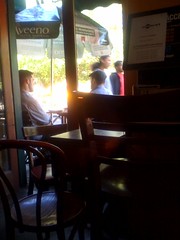
145 (corner): Ralph's, Italian ice chain, was Cafe Pick Me Up, congenial
coffeehouse for watching Alphabet City go by. ("Pick Me Up"
was a translation of Tiramisu, the Italian dessert.)
|
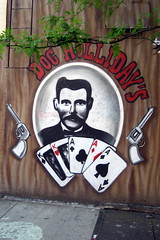
141 (corner):
Doc Holliday's, ironic yet rowdy Country bar. Clog-dancing on the bar.
Said to have the city's best Country jukebox.
Named for the
victor of the Gunfight at the OK Corral.
139: Was Sustainable NY, recycled goods +
cupcakes, which had been Hopscotch!, a kid-friendly coffeehouse;
before that
alt.coffee, grungy, long-running Internet cafe.
137: Rosella, sushi
135: Friendly, authentic dive bar. Lucy,
the maternal Polish owner, has been tending bar here since
it was Blanche's on St. Marks Place.
131 (corner): TabeTomo, ramen, was Kai Kai, tiny Thai
named for the phrase "who sells hen's eggs," which in Thai
is the word "kai" pronounced four different ways. Now expanded
into the next door space that was
Accidental CDs, a grungy 24-hour used CD
store that was about the last punk thing on the
avenue; briefly was a bakery for dogs, which was a
little too Paris Hilton. Next to that is Flea Market Cafe, a French restaurant/cafe.
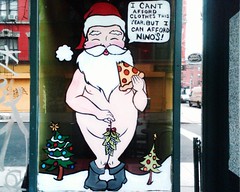 Nino's Pizza of NY used to serve decent slices
(and Italian ice) on the corner; a favorite stop
for my 4-year-old (as well as for comedian David Cross).
Nino's Pizza of NY used to serve decent slices
(and Italian ice) on the corner; a favorite stop
for my 4-year-old (as well as for comedian David Cross).
|
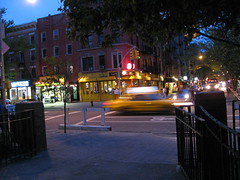
Corner (132 St Marks): Sushi Lounge,
formerly Friends
2 sushi, was biker bar Alcatraz. There's
a mosaic on the north wall celebrating the
Constitution's bicentennial.
123: Fares Deli-Grocery
121: Was Tompkins Park Laundromat
119: Was Odessa, classic Ukrainian diner; this was the new incarnation, which coexisted with the original two doors down for some time.

117: Was Odessa Cafe, the classic diner with a
ceiling that appeared to be shag carpeting painted red.
115: Was Alphabets, cards, T-shirts, kitsch, tchotchkes.
113: Ray's Candy, newspaperless newsstand
noted for its egg creams.
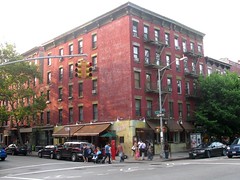
111 (corner): Yuca Bar, a hip Latin restaurant, was
Leshko's, a long-running grungy Ukrainian
diner, then a slick lounge.
|
|
|
East:
Tompkins Square Park
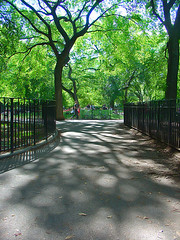
Named for Daniel Tompkins, governor of New York (1807-16) and U.S. vice president (1817-25), a populist who
abolished slavery in New York.
Earlier a salt marsh owned by Peter Stuyvesant, the
park was drained and developed in 1834. After being the site of bread
riots in 1857 and draft riots in 1863, it was leveled in
1866 and turned into a National Guard parade ground. When German
socialists gathered here in 1874 to protest the
faltering economy, police injured hundreds in
what was called the Tompkins Square Massacre.
Neighborhood protests resulted in the re-establishment
of the park by 1879; part of the redesign was by Frederick Law
Olmstead, but most of his plan was not implemented. Reconstructed by Robert Moses in 1936.
A bandshell erected in 1966
was venue for concerts by Jimi Hendrix and Grateful Dead. When
38 people were arrested for playing conga drums, a judge
threw out charges, citing "equal protection for the unwashed,
unshod, unkempt and uninhibited." In 1985, the bandshell
became the venue for the first Wigstock.
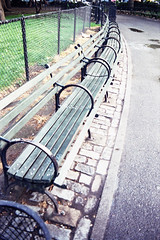
In the 1970s and '80s, the park became a homeless encampment, as depicted in the
Don Delillo novel Mao II. (The park
also appears in the Philip Roth novel
My Life as a Man, as the spot
where a character arranges to buy urine
from a pregnant woman.) A friend who grew up
in New York says that he and his friends used to dare
each other to go in. In August 1989, murderer
Daniel Rakowitz
served soup to the homeless here that may
or may not have contained the remains
of his roommate Monika Beerle.
Attempts to evict the homeless led to the August
1988 police riot, when 44 were injured by cops with tape over
their badge numbers. After the Memorial Day Riot in 1991,
Mayor David Dinkins closed park for 14 months' of renovations,
including the destruction of the bandshell. The park now has a midnight curfew.
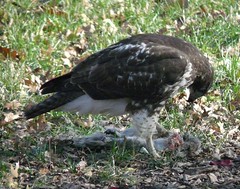
Though Pale Male in Central Park gets all the press,
Tompkins Square has also been a habitat for red-tailed
hawks since at least 2004.
The blacktop in the northwest corner of the park
is one of Manhattan's prime skateboarding spots--known
as the TF, the Training Facility.
Only three trees survive in the park that are older than 1866,
all sycamores; one of them is here, at the corner of 9th and A.
Avenue A Playground
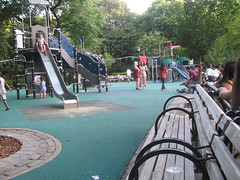
The center of toddler social life
in the East Village. If you're a regular here,
you may know me as "Eden's father." Closed for
renovation from October 2008 until July 2009.
A scene in Die Hard With a Vengeance was filmed in this
corner of the park. The movie Hurricane Streets,
directed by Morgan Freeman, also features
Tompkins Square. Murder victims frequently
turn up here on NYPD Blue.
Samuel Cox statue
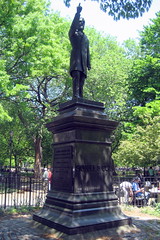
The statue appearing to hail a taxi in the park's
southeast corner is of a U.S. representative who
promoted the rights of mail carriers
and created the modern Coast Guard. It used to
stand in Astor Place, where the Cube is now.
|
|
